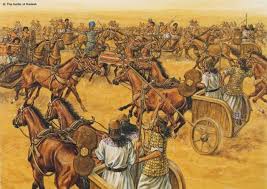If the enemy waited at the end of the ravine, the Egyptians (Egyptian Battles) would risk being cut down before they had a chance to respond. The army leaders pleaded with him not to take the difficult road but to take either of the two easier roads. Instead, with information from the scouts, Thutmose III decided to take the direct path to Megiddo. He believed that if his generals advise him the easy route, then his enemy would also, so he decided to do the unexpected.
About Egyptian Battles
 The King of Kadesh had left large infantry detachments guarding the two more likely paths and virtually ignored Aruna, the narrow mountain pass coming in from the south. Ignoring the danger of spreading out his army in the mountains where his soldiers might be subjected to enemy ambush in narrow mountain passes and his main force, still far behind in Aruna, unable to come to their aid, Thutmose took the direct route through Wadi Ara. To reduce the risk, Thutmose himself led his men through Aruna.
The King of Kadesh had left large infantry detachments guarding the two more likely paths and virtually ignored Aruna, the narrow mountain pass coming in from the south. Ignoring the danger of spreading out his army in the mountains where his soldiers might be subjected to enemy ambush in narrow mountain passes and his main force, still far behind in Aruna, unable to come to their aid, Thutmose took the direct route through Wadi Ara. To reduce the risk, Thutmose himself led his men through Aruna.
With his infantry and the light cavalry of mounted bowmen, known as haibrw or the horsemen, going by the side of the mountains, to take out any scouts that might be posted and leaving the road to the main force of chariots, he moved in quickly. With the city lightly guarded by the enemy, Thutmose led a quick assault, scattered the rebels and entered the valley unopposed. Now, the Egyptian army had a clear path to Megiddo, with large parts of the rebel army far away to the north and south.
Thutmose seized the opportunity. He set up camp and, during the night, arrayed his forces close to the enemy. The next morning, they attacked. The surprised King of Kadesh had no time to prepare for Egyptian Battles. His rebel forces were on high ground adjacent to the fortress. The Egyptian line was arranged in a concave formation, consisting of three wings that threatened both rebel flanks. Both the Egyptians and the rebels are estimated to have had around 1,000 chariots and 10,000 infantry.
The Pharaoh led the attack from the center. The combination of position and numbers, superior maneuverability of their left wing along with an early, bold attack, broke the enemy’s will; their line immediately collapsed. Those near the city fled into it, closing the gates behind them.
The Egyptian soldiers fell to plundering the enemy camp. Unfortunately for the Egyptians, during this confusion the scattered rebel forces, including the Kings of Kadesh and Megiddo, were able to rejoin the defenders inside the city walls. Those inside lowered ropes to the men and chariots outside and pulled them up over the walls. Thus, the opportunity of a quick capture of the city following the Egyptian Battles was lost.
Siege of Mediggo
The city was besieged for seven months and the King of Kadesh escaped. Thutmose set up siege-works and encircled the town, eventually forcing its occupants to surrender. At Karnak, it is recorded that the victorious army took home 340 prisoners, 2,041 mares, 191 foals, 6 stallions, 924 chariots, 200 suits of armor, 502 bows, 1,929 cattle, 22,500 sheep, and the royal armor, chariot, and tent-poles of the King of Megiddo. The city and citizens were spared. A number of other cities in the Jezreel Valley were conquered and Egyptian authority in the area was restored.
Result of the Campaign
Right from his first campaign in the Levant, Thutmose’s personal scribe Tjaneni kept a journal on parchment. These annals describe in lavish detail all the campaigns led by Thutmose III. After the victory at Megiddo and his successful campaigns in the Levant over the next 20 years, Egypt’s rise to power in the international community and its evolution into an empire is evident in the annals.
Depictions show international diplomacy through the giving of gifts from Babylon, the Hittite Empire, and other prominent and powerful regions during this time period. Egypt’s realm was expanded by this campaign. By re-establishing Egyptian dominance in Palestine, Thutmose began a reign in which Egypt reached its greatest expanse as an empire. Thutmose III required from the defeated Kings that they each send a son to the Egyptian court. There, they received an Egyptian education.
When they returned to their homelands, they governed with Egyptian sympathies. Nevertheless, the victory at Megiddo was only the beginning of the pacification of the Levant. Only after several further campaigns, conducted almost annually, was the unrest cooled.
